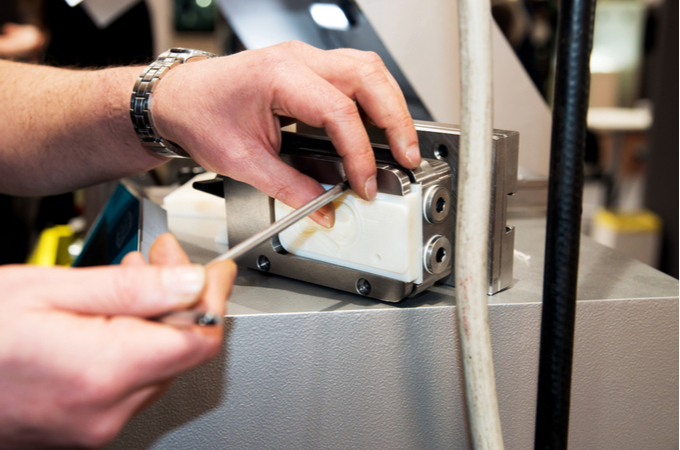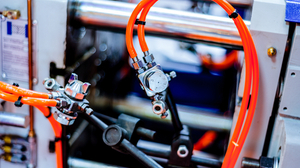
If you’ve experienced cushion issues in your injection molding process, you know the telltale signs: improper packing, insufficient pressure, inconsistent shot sizes — all adding up to much higher rates of unacceptable, discarded parts. Cushion is a critical concept and practice in injection molding, as it provides a necessary “buffer” to ensure that back pressure from the injection unit holds and packs the material in the injection cavity as needed.
Cushion problems can be difficult to identify, and often can be time consuming to remedy. With this article, our goal is twofold: to serve as a reminder to consider cushion as the source of injection molding issues you may be experiencing; and to provide some potential solutions that are easy to investigate and enact.
Before we move to those points, let’s talk about the definition of “cushion.” Why? Because it can differ from machine to machine and shop to shop. In order to successfully make use of the information in this piece, it’s important to understand how your machine is defining the melt cushion. Essentially, there are two definitions:
- Screw location at the end of the hold stage
- The farthest forward position that the screw reaches at any point throughout the injection process — first or second stage

Sometimes, these two numbers may be the same. Yet other times — for instance, if there is screw bounceback (which may be required and acceptable for materials or parts that call for lower holding pressures) — the numbers may vary. Review your machinery’s documentation to ensure that you’re “speaking the same language” when reading this and any other information about injection molding cushion issues.
Now that we have a baseline for defining cushion, let’s look at some potential issues with injection molded parts that an inconsistent cushion (or lack of cushion) can cause:
Most Common Causes of Inconsistent Cushion or Lack of Cushion
Incomplete/unformed parts: This is a very common issue that can occur if a cushion is not present, or is not present in an effective amount. As stated above, the purpose of cushion is to guarantee that pressure from the injection unit fully transfers to the material in the cavity to ensure proper packing and holding pressure. Pressure requirements are carefully calculated for part designs and machinery, and are reliant upon the process working as it should. Without cushion, more variability is introduced into the pressure equation, leading to part errors. Note that almost all injection molding machines have a “safety buffer” built in so that even when the screw zeros out, it doesn’t actually contact the end of the barrel (which can cause extensive damage to machinery, and is dangerous). If the cushion is not present, there’s effectively empty space between the screw and the sprue. It’s only logical that packing/holding pressure will become far too low in this scenario.
Inconsistent shot sizes: If your machine isn’t holding a consistent cushion, the shot amount for each part will be inconsistent, as greater or lesser amounts of material will be injected into the cavity on each shot. While parts may still be acceptably produced, inconsistent shot size can snowball into larger issues with machine setup. This can also lead to inefficiencies in material usage.
If you suspect that you may be having issues with cushion due to the above symptoms (or others), look into the following solutions:
Review your cushion setting: Is it a sufficient amount to fully transfer back pressure from the injection unit to the mold? Remember that while shot size and many other plastic injection molding measurements are made by volume, cushion should usually be gauged in distance. Volume can be highly variable when larger or smaller screw diameters are introduced. With a larger screw diameter, going by volume alone could potentially lead to almost no cushion at all. A good rule of thumb for cushion distance is 6 millimeters.
Review your pressure settings: Confirm that you have sufficient cushion before proceeding to this step. Then, check: Is there enough back pressure coming from the injection machine to sufficiently pack the material into the cavity, and to maintain pressure through the holding stage? If the part is of a complex design or a larger size than you typically manufacture, standard pressure settings may need to be adjusted.

Sufficient cushion and sufficient pressure settings are the fastest way to resolve these issues. If, however, the problem is still not remedied, try the following simple test to determine whether machinery issues may be to blame:
- Use a “dummy” slug to insert into the injection nozzle tip to block the actual flow of material (for testing purposes).
- Bring the nozzle into contact with the sprue.
- Charge and fire a shot of resin (with cushion).
- Gauge where the screw terminates. If it is closer to zero than it should be — based on shot measurement and cushion — you may have a machinery hardware issue. Check the barrel, screw; and check ring for wear or damage.
For more information about injection molding best practices, visit the RevBlog.

